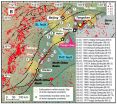Big data study identifies new potential target coating for drug-eluting stents
Results published in the Journal of Clinical Investigation
2014-11-18
(Press-News.org) NEW YORK, NY - November 17, 2014 - A new study has identified an FDA approved cancer drug, crizotinib, as a possible new coating for drug-eluting stents. Researchers found that crizotinib in mice helped prevent the narrowing of blood vessels after stenting without affecting the blood vessel lining. Results of this study were published today in the Journal of Clinical Investigation.
To find a more effective drug to use on stents, researchers used a computational biology or "big data" approach to better understand the genetic pathways of re-narrowing that occurs in stented vessels or in-stent stenosis. Caused by the buildup of scar-like tissue in the inner walls of heart vessels, the disease can often lead to the return of symptoms or heart attacks.
"This study features an innovative approach to research - the opportunity to take big data to identify non-obvious mediators of disease and then investigate them as potential therapeutics. We identified a prospective candidate for drug-eluting stents that inhibits in-stent stenosis without affecting the endothelium," said Ziad A. Ali, MD, DPhil, lead author of the paper. Dr. Ali was a cardiovascular fellow at Stanford University during the first years of the study. He was also the first person to publish a mouse model of angioplasty and stenting in the Journal of Arteriosclerosis, Thrombosis, and Vascular Biology in 2007 allowing for the investigation of therapeutic targets for stent injury and restenosis in genetically modified mouse strains. He is now the Associate Director of Translational Science at Columbia University Medical Center and a Physician Contributor at the Cardiovascular Research Foundation.
The most common treatment for a blocked artery is balloon angioplasty and placement of a stent, a metal scaffold used to keep the artery open. More than one million procedures are performed annually in the United States. A limitation of this procedure is in-stent stenosis, the re-narrowing of the blood vessel by scar-like tissue leading to restricted blood flow. To combat this, drug-eluting stents are used to block the growth of this scar-like tissue around the stents. However, current agents used in drug-eluting stents also inhibit the regrowth of the endothelium (or lining of the blood vessel) which can increase the risk of blood clots and heart attacks. As such, patients treated with drug-eluting stents require treatment with blood thinners to prevent stent blockage from a blood clot. Thus, treatment with drug-eluting stents can be less desirable for people with bleeding problems or those who need surgery after a stent is placed.
Researchers combined a text analysis of medical literature with data from large-scale genetic studies in humans to develop a theory that they then tested in the laboratory with a genetically modified mouse model. Using a gene network analysis of coronary artery samples collected from 89 patients in Germany, they identified the gene GPX1, a naturally occurring antioxidant, as associated with cardiovascular events. They tested this by studying mice with atherosclerosis in which the gene had been knocked out. Plaque increased significantly in the arteries of mice with knocked out GPX1.
In further gene interaction analyses, researchers also found that there was an increased risk of the disease from interaction between GPX1 and ROS1, a gene previously found to be important in cancer. Researchers then used crizotinib, a chemotherapy drug used as a personalized medicine treatment for certain lung cancers, to test whether the inhibition of ROS1 could help reduce the damage to blood vessels. The drug was used in mice with atherosclerotic disease surgically implanted with stents. Researchers found that the drug reduced in-stent stenosis without impairing the endothelium growth.
"These findings highlight the need for targeted rather than broad-spectrum therapies and can affect how we treat future patients," said Euan Ashley, MD, senior author of the study and Associate Professor of Cardiovascular Medicine and Genetics at the Stanford University School of Medicine. "These results indicate that patients who receive drug-eluting stents with crizotinib may someday no longer be required to take blood thinners after balloon angioplasty and stenting."
INFORMATION:
The study was funded by the National Institutes of Health (grants 4R00HL109256, R00HL089413, DP2OD004613 and R01 HL105993) among others.
About CRF
The Cardiovascular Research Foundation (CRF) is an independent, academically focused nonprofit organization dedicated to improving the survival and quality of life for people with heart disease through high quality research and education. Since its inception in 1991, CRF has played a major role in realizing dramatic improvements in the lives of countless numbers of patients by establishing the safe use of new technologies and therapies in interventional cardiovascular medicine.
For more information, visit http://www.crf.org.
ELSE PRESS RELEASES FROM THIS DATE:
2014-11-18
November 18, 2014 -- A study just released by Columbia University's Mailman School of Public Health found that children who were exposed to antibiotics in the second or third trimester of pregnancy had a higher risk of childhood obesity at age 7. The research also showed that for mothers who delivered their babies by a Caesarean section, whether elective or non-elective, there was a higher risk for obesity in their offspring. Study findings are published online in the International Journal of Obesity.
Although previous studies have shown that antibiotics administered early ...
2014-11-18
Boulder, Colo., USA - With a population of 11 million and located about 100 km from Beijing (22 million people) and Tangshan (7 million people), Tianjin lies on top of the Tangshan-Hejian-Cixian fault that has been the site of 15 devastating earthquakes in the past 1,000 years. An example of the disastrous events is the 1976 magnitude 7.6 Tangshan Earthquake, which killed a quarter million people.
To assess future seismic hazards along the fault, scientists from the University of California at Los Angeles (UCLA) and the Chinese Earthquake Administration (CEA) have reconstructed, ...
2014-11-18
In an extensive, multi-institution study led by SUNY Downstate Medical Center, researchers have identified new evidence supporting the growing belief that Neanderthals were a distinct species separate from modern humans (Homo sapiens), and not a subspecies of modern humans.
The study looked at the entire nasal complex of Neanderthals and involved researchers with diverse academic backgrounds. Supported by funding from the National Science Foundation and the National Institutes of Health, the research also indicates that the Neanderthal nasal complex was not adaptively ...
2014-11-18
WASHINGTON D.C., November 18, 2014 -- A research team from Germany developed an analytical model to describe the structural dynamics of photoexcited thin films and verified it by ultrafast X-ray diffraction.
Lattice dynamics, atomic movements in a crystal structure, can influence the physical and chemical properties of a material. The phenomenon can be directly studied using ultrafast X-ray diffraction, in which femtosecond X-ray pulses take snapshots of the atomic positions in a crystal by interacting with the structure at the core electronic level.
However, no comprehensive ...
2014-11-18
An investigational treatment for Marfan syndrome is as effective as the standard therapy at slowing enlargement of the aorta, the large artery of the heart that delivers blood to the body, new research shows. The findings indicate a second treatment option for Marfan patients, who are at high risk of sudden death from tears in the aorta.
The results are being presented Nov. 18 at the American Heart Association's annual meeting in Chicago and will appear online the same day in the New England Journal of Medicine.
"For years, standard medical therapy for Marfan syndrome ...
2014-11-18
Each cell contains thousands of proteins, each one of which bears a unique signature. All proteins, distinct in shape and function, are built from the same amino acid strings. Many proteins are vital, as evidenced by the plethora of diseases linked to their absence or malfunction. But how exactly did proteins first come to be? Do they all share a single common ancestor? Or did proteins evolve from many different origins?
Forming a global picture of the protein universe is crucial to addressing these and other important questions, but it's nearly impossible to do. Such ...
2014-11-18
URBANA, Ill. - Most Americans don't get the daily recommended amount of fiber in their diet, though research has shown that dietary fiber can cause a shift in the gut toward beneficial bacteria, reducing the risk of colon cancer, type 2 diabetes, and other diseases. A new study from the University of Illinois shows that two specific functional fibers may also have the potential to assist in weight loss when made part of a long-term, daily diet.
Kelly Swanson, a U of I professor of nutrition, and his team had previously been able to see a "snapshot" of what bacteria were ...
2014-11-18
When NASA's Terra satellite passed over the Southern Indian Ocean, the MODIS instrument aboard captured a picture of Tropical Cyclone Adjali that showed it developed a "tail," which is actually band of thunderstorms extending south of the center.
The Moderate Resolution Imaging Spectroradiometer, or MODIS instrument that flies aboard NASA's Terra satellite took a visible picture of Tropical Storm Adjali on Nov. 18 at 05:35 UTC (12:35 a.m. EST). The MODIS image showed a concentration of strong storms around the center of Adjali's circulation and a band of thunderstorms ...
2014-11-18
A peek inside the brains of professional musicians has given University of Texas at Arlington psychology researchers what may be the first links between music expertise and advantages in long-term memory.
Heekyeong Park, assistant professor of psychology, and graduate student James Schaeffer used electroencephalography (EEG) technology to measure electrical activity of neurons in the brains of 14 musicians and 15 non-musicians and noted processing differences in the frontal and parietal lobe responses. The team will present initial results of their new research Tuesday ...
2014-11-18
Motor vehicle crashes are the most common cause of unintentional life lost around the world, with about 30,000 deaths occurring annually in the U.S. due to motor-vehicle crashes.
A study by a doctoral student in epidemiology at the Indiana University Richard M. Fairbanks School of Public Health at Indiana University-Purdue University Indianapolis showed that vehicle inequities have a significant impact on survivability in head-on collisions.
Uzay Kirbiyik conducted a study of risk factors associated with drivers' survival in head-on vehicle collisions by examining ...
LAST 30 PRESS RELEASES:
[Press-News.org] Big data study identifies new potential target coating for drug-eluting stents
Results published in the Journal of Clinical Investigation




